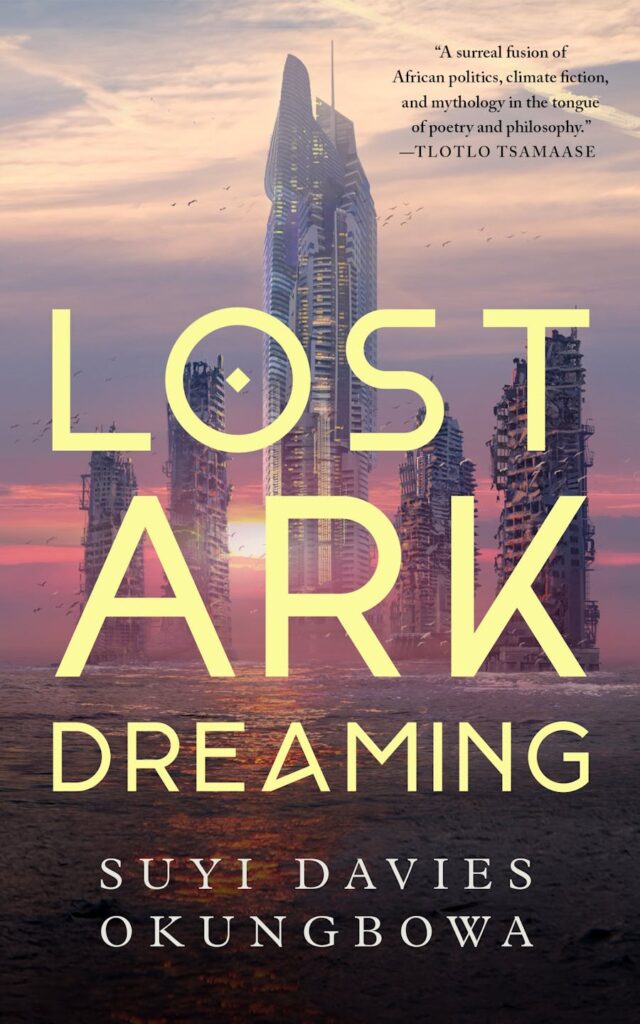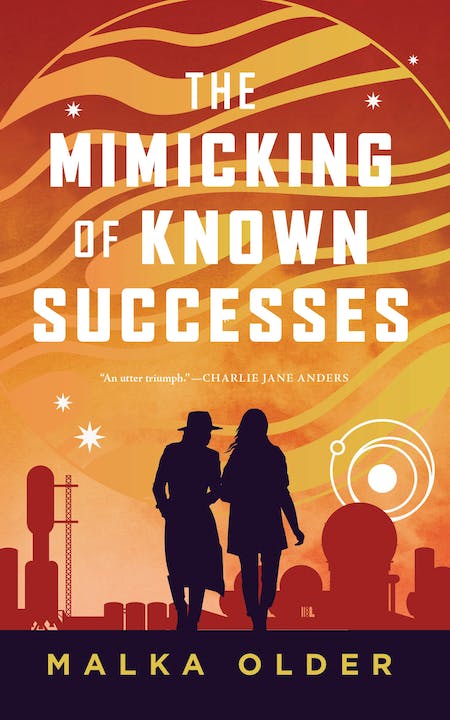Book Review: Lost Ark Dreaming, by Suyi Davies Okungbowa

I had forgotten the publisher’s description of Lost Ark Dreaming, by Suyi Davies Okungbowa, by the time it surfaced atop my to-be-read pile. So I went in cold, and it turned out that the water was fine! This is a gripping novella that starts fast and keeps moving with swift assurance, amid brief interludes and “historical excerpts” that give more context to the action, while deftly building characters whose revealed motivations make even some surprising decisions feel natural. I enjoyed it quite a lot. Suyi Davies Okungbowa is a rising star in speculative fiction, a Nommo Award winner who has appeared twice before on Skiffy and Fanty’s website. Tonya Moore interviewed him about his work in general and specifically his The Nameless Republic trilogy. Paul Weimer’s review of the first two books in that series praised the immersive worldbuilding and said, “the two books really feel like to me a study and critique of decaying imperial power, and what happens when that eroding power slips…” Power is a major focus in this novella, too, although it’s unrelated to his previous books. Tiers of power are given physical reality, as the Uppers, Midders, and Lowers live in their respective floors of offshore towers after the seas rose and drowned Lagos, Nigeria, and surrounding coastal areas. The higher Up that one lives, the more authority, light, fresh air, and space one has; Midders keep things running and try to keep themselves from falling in status; and Lowers work and scramble to survive, down in the dark, dank floors below sea level. This novella starts off feeling like a combination of climate fiction and science fiction, although faith and fantasy elements also make themselves known eventually. Although most of the viewpoint characters (a Midder, an Upper, and a Lower) start out trying to focus on the here-and-now, and submerging past traumas (the Upper has done this so successfully that the reader sees only his ambitions throughout much of the book), events force them to confront their memories and longings for connection with other people, with the environment, and with the Unknown. Lost Ark Dreaming starts with Yekini rushing to get to work, but she hardly has time to start stressing out about the effects of lateness on her career as an analyst in civil service before she’s sent on her first solo field assignment—as a punishment? Unfortunately, it’s a trip to the Undersea levels; more unfortunately, she has to shepherd an Upper official, Ngozi, there, protecting him while trying to make him feel sufficiently deferred to; even more unfortunately, when a Lowers-level head of safety, Tuoyo, leads them to the site of a breach that she’d already patched, Yekini discovers indications of an intruder. Things rapidly spin out of all their control to go from bad to worse. Some readers may be annoyed that the novella is slightly open-ended, with no sure societal resolution to the climactic events of the finale. But the protagonists all make important decisions, including some self-sacrifices aimed at helping their community. To me, this has a hopeful ending, and I can say I am very well satisfied with the book. Along with the strong plot and characterization, the language craft in this book is worth mentioning. The Interludes are poetically dreamy, and some of the “historical excerpts” are intentionally distant and formal, but most of the prose is vivid and active. Descriptions put the reader right there: “The Lowers smelled like a damp cloth that had been locked in a steel box for years… the air weighed a ton, and Yekini’s lungs worked hard to draw it in. Her chest felt waterlogged, like a bad cough brewing.” A lot of the worldbuilding here is concrete, but I also love what the author can do with just one sentence: “Ensconced within the [glass] pendant was a flash of color, the only valuable part of the necklace—a small remnant of an aged, wrinkled orange peel.” That sets the reader imagining what kind of ruined world makes a relic like that so valuable. I love the little details like that. Finally, I’ll also mention that some elements of African culture that are woven throughout Lost Ark Dreaming enhanced my enjoyment of it—I say African rather than Yoruban, although that language is specifically mentioned, because refugees of various backgrounds have made their way to the towers, and some elements of religion, for example, have evolved to fit current circumstances. These elements strongly affect some characters’ motivations and decisions. There are further things I’d like to say about works that this novella is clearly in conversation with, but that would give away major spoilers, so I’ll stop here. Just know that Lost Ark Dreaming has my strong recommendation. Lost Ark Dreaming’s expected release date is May 21, so there’s still a short time to give it some extra love by pre-ordering it. https://us.macmillan.com/books/9781250890757/lostarkdreaming Content warnings: Blood, past traumas, threatened violence, offscreen mass deaths, bad air and filth, class oppression. Comparisons: Per the publisher’s description, “The brutally engineered class divisions of Snowpiercer meets Rivers Solomon’s The Deep …” Disclaimer: I received a free eARC of this novella for review purposes.
Review: The Mimicking of Known Successes, by Malka Older

Malka Older’s The Mimicking of Known Successes is a lovely cozy mystery and sapphic romance in a tonally nearish-future SF setting. If, like me, you struggled a bit with author Malka Older’s Centenal Cycle trilogy (I admit I haven’t made it past the first book, Infomocracy), please consider giving this novella a try. It was one of my favorite things to read this year. One of the reasons I had stumbled during Infomocracy was the multiple characters and POVs – sometimes I’m good with that, but I started reading it in 2019, not a great year for me to be challenging myself during leisure time. But TMoKS starts with a tight-focus third-person narrative focused on Mossa, a professional detective, and switches to a first-person narrative from Pleiti, a scholar, so it’s a lot easier to track what’s happening (although intentions and motivations aren’t revealed for quite a while). Also helping with the ease of reading is that although this is science fiction, the tone feels like gaslamp Victorian/Edwardian-style fiction, minus the racism and sexism (there’s still some degree of classism, though, at least with some characters being arrogant about their academic status). Humanity has moved to Jupiter after wrecking the Earth’s environment, with a series of platforms in the upper atmosphere of the gas giant that are connected via a rail system. So as Mossa and Pleiti follow leads from platform to platform, it reminds me a lot of various Sherlock Holmes mysteries where he and Dr. Watson move about tEngland via rail. Also, Pleiti’s university quarters provide tea and scones by the fireside as a welcome warm-up for the pair in Chapter 1, so the mystery is literally cozy. It is also pretty hot in places! Mossa and Pleiti are ex-flames from college, who had a bad breakup. The two have very different interests, competencies, and personalities, but the heat is still there; at least we see that on Pleiti’s side before too long. And when one of them is injured, the other helps bathe the wound clean and has to struggle to keep her mind, emotions and voice under control… Fortunately, frustrations are eventually resolved satisfyingly – but I definitely want to see this relationship continue to progress in future stories. As for the mystery, I love how it spins up step by step (with a few twists and turns along the way) from a missing person to a case with much broader implications. Some SF mysteries are basically just present-day puzzles with a technological gloss, but the futuristic setting here is integral to the mystery and to people’s motivations, and the complex details of the worldbuilding (from simple elements like an atmoscarf that helps one breathe outside, to vital plot-spoilery ones) really immerse the reader into the story. Incidentally, the title comes from humans on Jupiter trying to figure out how to recreate Earth’s environment – Pleiti’s Classics discipline actually centers not so much on interpreting literature as on using literature to infer whole working ecologies, such as cataloging plant life in (implied) Watership Down. It’s certainly not cozy to imagine the devastated Earth, but I’ve been reading some other “cozy catastrophes” lately, where the coziness lies in survivors starting small and building futures together, and this fits that description. Older has said that she set out to write a comfort read, and I believe she succeeded masterfully. Worldbuilding, mystery, characters and romance combine delightfully in this novella. I eagerly await the sequel in February 2024, and, fortified by this lovely story, I may even return to the Centenary Cycle. The Mimicking of Known Successes, available here from Barnes & Noble, has a sort of subtitle these days: “The Investigations of Mossa and Pleiti Book 1.” Yes, that means there is a follow-up coming! The Imposition of Unnecessary Obstacles is available now for preorder. I am definitely looking forward to reading that! Content warnings: Violence, death, past background environmental catastrophe, sexy scenes (not graphic). Comparisons: C.L. Polk’s Even Though I Knew the End (noirish f/f romance-fantasy-mystery), Everina Maxwell’s Winter’s Orbit (mostly cozy m/m romance-SF with some mystery), P. Djeli Clark’s A Master of Djinn (steampunk-mystery with f/f romance). Disclaimers: I received a free ARC of this novella from NetGalley. IIRC, I may have had a few very brief exchanges with Older on social media.
Book Review: Dehiscent by Ashley Deng

Dehiscent has a form of New Weird that combines eco-horror with what might be considered cozy horror, despite unsettling themes of the prison that can form from the recognition of privilege while feeling powerless to change it. With rich, quiet atmosphere and an exceptionally compelling and realistic, empathetic protagonist, Deng lifts a mirror to our current lives to reflect a fantastic image of how divisions of humanity would continue.
Book review: The Levee by Damon Norko
Everybody from J.G. Ballard to Paolo Bacigalupi to George Miller has tackled the “extreme drought” future, but few have taken it quite as far as Damon Norko has done in his latest novella, The Levee. The world of The Levee is one in which not only have the rivers and lakes dried up, but so have the oceans. Barsoom-like*, humanity now dwells on the dead sea bottoms, and water, pumped from deep under those bottoms, has become so scarce and precious that it is used as currency, making for a weird and cumbersome economic system that I’ll expand upon later in this review.
Guest Post: CliFi, et al. by Marianne de Pierres

Marianne de Pierres is the author of the popular PARRISH PLESSIS trilogy and the award-winning SENTIENTS OF ORION and PEACEMAKER series. The PARRISH PLESSIS series has been translated into many languages and adapted into a role-playing game, while the PEACEMAKER series is being adapted into a novel adventure game. The sequel to PEACEMAKER, MYTHMAKER was just released by Angry Robot Books. Fictional dystopias born from climate change are increasingly prevalent in fiction. Not that it’s a new concept … JG Ballard wrote The Wind from Nowhere, The Drowned World and The Burning World back in the ’60s, and they weren’t the first CliFi novels by any means. Jules Verne, I believe, wrote one in 1889. Recently though, the sub-genre has gained momentum as particularly seen in the success of Paolo Bacigalupi’s The Windup Girl, and Margaret Atwood’s Oryx and Crake trilogy.

